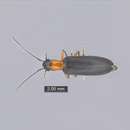en
names in breadcrumbs



The Tenebrionoidea are a very large and diverse superfamily of beetles.[1] It generally corresponds to the Heteromera of earlier authors.
Tenebrionoidea contains the following families:
The largest family by far is Tenebrionidae, with (as of 2014) approximately 20,000 species and almost two-thirds of the species richness of the superfamily.[2]
The Tenebrionoidea show a range of different morphologies. However, one characteristic of most adults is having 5 tarsomeres on the fore- and midlegs, and 4 tarsomeres on the hindleg (tarsal formula 5-5-4). Occasionally, males have tarsal formula reduced to 4-4-4, 3-3-3 or 3-4-4.[2]
Larval Tenebrionoidea can be distinguished by various features of the head: a posteriorly diverging gula with well developed gular ridges, posterior tentorial arms being shifted anteriorly, asymmetric mandibles, the M. craniocardinalis vestigial or absent, and the M. tentoriopharyngalis posterior subdivided into several bundles. The body is usually sub-parallel and slightly flattened, but other shapes have evolved to suit different needs, such as cylindrical for boring larvae, strongly flattened for larvae living under bark, and c-shaped and grub-like for larvae with specialised developmental strategies (e.g. post-triungulin larvae of Rhipiphoridae and Meloidae).[1]
Many tenebrionoid families are fungus feeders, but there are a wide range of other feeding strategies including feeding on wood or on decaying plant material, pollen-feeding (by many Oedemeridae and Anthicidae), and acting as ectoparasitoids of other insects (Ripiphoridae). A small number of species are predators or feed on living plant tissue.[2]
Tenebrionoidea show a particular diversity in arid environments.[2] One adaptation shown by some (e.g. Onymacris unguicularis) is the ability to gather water from fog in order to drink.[3]
 Synchroa punctata larva
Synchroa punctata larva The Tenebrionoidea are a very large and diverse superfamily of beetles. It generally corresponds to the Heteromera of earlier authors.